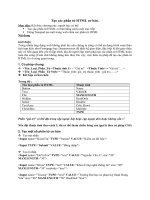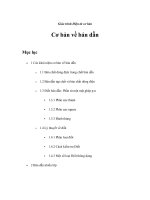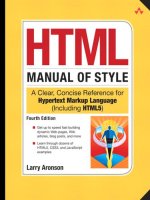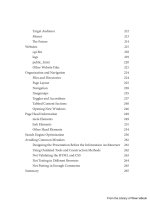HTML cơ bản - p 2 pptx
Bạn đang xem bản rút gọn của tài liệu. Xem và tải ngay bản đầy đủ của tài liệu tại đây (561.09 KB, 10 trang )
ptg
Target Audience 212
Money 213
e Future 214
Websites 215
cgi-bin 218
logs 219
public_html 220
Other Website Files 221
Organization and Navigation 224
Files and Directories 224
Page Layout 225
Navigation 228
Imagemaps 235
Toggles and Accordions 237
Tabbed Content Sections 240
Opening New Windows 246
Page Head Information 249
meta Elements 249
link Elements 251
Other Head Elements 254
Search Engine Optimization 256
Avoiding Common Mistakes 261
Designing the Presentation Before the Information Architecture 261
Using Outdated Tools and Construction Methods 262
Not Validating the HTML and CSS 263
Not Testing in Dierent Browsers 264
Not Putting in Enough Comments 265
Summary 265
From the Library of Wow! eBook
ptg
Appendix A: HTML5 Quick Reference 267
Root Element 268
Document Head Elements 268
Section Elements 269
Heading Elements 270
Block Elements 270
List Elements 271
Inline Elements 271
Embedded Elements 273
Table Elements 275
Form and Control Elements 276
Legacy Elements 277
Appendix B: CSS Properties 279
Explanation of Values 279
CSS Properties 280
Aural Properties 300
Index 305
From the Library of Wow! eBook
ptg
xii
Acknowledgments
I would like to acknowledge and express my gratitude to my acquisitions
editor, Trina MacDonald, whose patient guidance and understanding made
it possible for me to have fun working on the project despite the pressures of
deadlines. I would also like to thank my development editor, Songlin Qiu,
who caught my errors and turned around chapters with lightning speed, and
Elliotte Rusty Harold, who checked my facts and, as mentioned in the pref-
ace, started the whole process. Finally, I am deeply grateful to my wife, Heidi
Cohen, who helped me nd my writing voice and contributed signicantly to
my knowledge of online marketing and search engine optimization.
From the Library of Wow! eBook
ptg
xiii
A A
Larry Aronson grew up in Evanston, Illinois, graduated with honors from
Evanston Township High School, and attended the University of Illinois in
Champaign-Urbana. Before graduating with a BA in computer science and a
BS in psychology, he worked two summers as an assistant systems engineer
with IBM’s Chicago manufacturing branch oce.
Aer graduation, Aronson visited New York City, fell in love, and decided
to live there. He worked at a number of jobs in New York’s radio, theater,
and recording industries before returning to computers working for the user
services department of Columbia University’s Center for Computing Activi-
ties. Four years later, with faculty status and postgraduate work in electrical
engineering and computer science, but little money, he le academia to work
for Boeing Computer Services, starting as a technical sales representative and
working his way up to tech manager of BCS’s New York oce.
Aronson le Boeing to start his own business as an independent con-
sultant aer seeing his rst personal computer. His rst client was the CBS
News election unit, where he wrote the House Race Analysis Model and other
components of their election system. His other major client was the Product
Safety Information Systems division of Mobil Oil Company. Aronson was the
principal programmer responsible for migrating Mobil’s safety data publishing
systems to a relational database management system and to graphical, full-
screen, data-entry and display technology.
In late 1993, Aronson downloaded Mosaic from his alma mater and discov-
ered the World Wide Web. He became active in the newsgroups and discus-
sion lists devoted to Web authoring and publishing, and in mid-1994, wrote
the rst book on Web publishing, HTML Manual of Style, for Zi-Davis Press.
e rst edition went through ve printings and seven foreign languages, and
the second edition, HTML3 Manual of Style, was equally successful. By 1995,
he was teaching HTML around the country and online, conducting the inau-
gural classes for Zi-Davis University on CompuServe.
Aronson lives in a Manhattan lo in the heart of “Silicon Alley.” He devotes
his time to building Web applications for individuals and small businesses,
helping people work and live on the World Wide Web. He was a founder of the
World Wide Web Artists’ Consortium, a board member of the New York So-
ware Industries Association, and a founding member of the Social MediaClub.
From the Library of Wow! eBook
ptg
xiv
Preface
What This Book Is About and Why You’ll Find
It Useful
is book is about using HTML to put your stu on the Web. HTML (Hyper-
Text Markup Language) is the language that tells a web browser what to do
with the text, images, and other media—the stu—you want others to see.
ere are good ways to use these tools, and there are bad ways. Web brows-
ers are smart application programs. ey can take badly written HTML and
still present a respectable-looking web page. However, there are still very good
reasons for learning how to write good markup. is book is about creating
web pages that
.
Are pleasing to look at and fun to play with
.
Are friendly to search engine robots
.
Are easy to update and maintain over time
e Web can be understood through a number of metaphors that allow us
to think of a website as a place within a realm we explore. We even socialize
within its “spaces.” But that is just a useful illusion. Under the hood, the Web
is not like that at all. Chapter 1 introduces the client/server technology that
web authors and developers use to create the illusion. Even if you consider
yourself an experienced web user, Chapter 1 is worth skimming.
Chapter 2 is all about the elements of HTML, including some of the more
interesting HTML5 additions. It has many examples illustrating how to mark
up documents semantically so that the resulting web page provides all the
right information to readers, both human and robot, and that it is easy to
update.
Our rst obligation in design is to please ourselves. With good document
structure, a website can be easily styled in a consistent manner across all
pages. Chapter 3 explains, with many examples, how to use Cascading Style
Sheet (CSS) statements to apply styling to document elements and create
people-pleasing web pages.
Chapter 4 is about using HTML as a contributor to other websites that
accept marked-up content. Five examples are given: blogging, Google Docs,
eBay selling, Wikipedia editing, and HTML email.
From the Library of Wow! eBook
ptg
xv
Despite the many options for putting content online, sometimes your orga-
nization’s objectives or your personal goals dictate building and running your
own website. Chapter 5 explores many of the issues involved, including website
structure, organization and navigation, and search engine optimization.
At the end of this book you’ll nd quick-reference guides to HTML ele-
ments and CSS properties, including the new elements and properties in
the HTML5 and CSS3 dra specications. ere is no list of references to
resources. e W3C’s website at w3.org and Wikipedia’s articles on HTML and
CSS should cover anything from a technical perspective. You know how to
search the Web for other guides, tutorials, and examples.
Finally, this book is about you, because you are changing from a person
who uses the Web for information and services to one who contributes to the
Web. People are discovering that the joys of online shopping pale in compari-
son to the pleasures of creative collaboration. ere is a place on this new Web
for your stu, and this book is about how to create content with style. I hope
you will nd it useful.
What’s Not Covered in This Book and Why Not
is book is not intended to be a complete reference guide to HTML5. Such
a book would be at least three times larger than this one and would be out of
date shortly aer publication. Web technologies are changing fast. e infor-
mation in this book is based on the World Wide Web Consortium’s (W3C)
dra recommendation for a proposed HTML5 standard. Although that might
sound a bit tenuous, much of the dra specication has already been adopted
by our favorite browsers (even though certainly much will change by the time
the standard is ocially approved). at being the case, I don’t claim to be an
authority on HTML5, only an author of a book on HTML5.
Along with HTML and CSS, JavaScript plays a part in some of this book’s
examples. Teaching JavaScript is way beyond the scope of this book, but it
is included for two reasons. First, the HTML5 specication formalizes the
behavior of document elements in response to user actions using JavaScript
syntax and methods. Second, JavaScript libraries, such as jQuery, provide rich
new vocabularies of element behaviors that previously were unavailable to web
authors and developers.
Other technologies play an important part in the operation of some web-
sites, but they are not really discussed in this book. If you want to learn about
using Microso’s Silverlight technology or Adobe’s Flash platform to develop
web pages, you’ve reading the wrong book. As a freelance developer, I tend
From the Library of Wow! eBook
ptg
xvi
to favor tools that are free and community-supported. It is not that I think
the tools I use are superior to these other technologies; I just have never used
them, and I don’t have a basis of comparison.
How This Book Happened and What’s to Come
e World Wide Web was born more than 20 years ago on the border of
Switzerland. When I rst became aware of the Web, I was working as a
consultant for one of those large Wall Street investment rms that no longer
exist. It was the fall of 1993, and I was converting a mainframe-based system
for modeling mortgage-backed derivatives to run on a minicomputer. I was
in the oce of the network administrator, whom I had become friends with,
and he was showing o a cool application he had recently downloaded from
the University of Illinois’ FTP site. It was called Mosaic. My life was about to
change, and I was ready for it.
At the time, I was already into the world of hypertext applications as an
avid fan and user of Apple Computer’s HyperCard application. I had created
a number of “stacks” (which is what HyperCard programs were called) for
myself and others. I kept up with the eld by participating in the Usenet news-
group, alt.hypertext, and local discussion groups on Panix, an early Internet
service provider (ISP) based in New York City.
I immediately saw the potential of Mosaic and the Web in its seamless
integration of anonymous File Transfer Protocol (FTP) and hypertext naviga-
tion. Prior to the availability of Mosaic, to read a particular document, rst
you had to know where that document was on the Internet. en you logged
in to that FTP server, downloaded the le, and opened it for reading. Not only
did Mosaic automate these intermediate steps, it also helped you nd the next
document you were interested in.
It was an exciting time. Dozens of new websites were appearing every
week. Updated versions of the web browsers available then—Mosaic, MacWeb,
WinWeb, and Arena—were released frequently, supporting more HTML
markup elements and new authoring abilities, such as centered text and inline
images. Every day, new techniques were discovered and shared in newsgroup
discussions and at usergroup meetings.
In the early summer of 1994, shortly aer the U.S. government allowed the
Internet to go commercial, I was contacted by another frequent newsgroup
contributor, Clay Shirky. He asked if I would be interested in meeting his
publisher, who was looking for a knowledgeable author to write a book about
HTML. Clay had other commitments, so I became the author of the rst book
From the Library of Wow! eBook
ptg
xvii
on Web publishing. Clay is an excellent writer. His books Voices from the Net,
Here Comes Everybody, and Cognitive Surplus are must-reads for anyone look-
ing to explore the cultural impact of new technologies.
e rst edition of this book came out at the end of 1994, and a second
edition, HTML3 Manual of Style, was published a year later.
1
Fast-forward
14 years to the fall of 2009, and I’m attending meetups and blogging about
HTML5. Another author of programming books, Elliotte Rusty Harold,
emails me, wondering if I would be interested in talking to his publisher about
redoing HTML Manual of Style. Talks led to a formal book proposal and a
contract, and now I’m an author again.
In reviewing the second edition, I came across this paragraph in the
Preface:
is is a book in the middle. e rst edition was written just before
HTML2 was nalized. Today, HTML is in the middle of the transition
to level 3. e Web itself is moving from an academic to a commercial
focus, and yours truly is in the middle of a career change from program-
mer/analyst to author/lecturer. Some of the topics covered herein are
illustrated using products that were still in beta testing, which means
that my best guess today may not accurately describe where the Web will
be tomorrow. is book will get you started in Web publishing; the rest
of your education will come online.
e sense of that paragraph is true again today. e Web is undergoing a
major technological upgrade as it expands from its commercial focus to
encompass and shape our social activities. Support for the emerging HTML5
and CSS3 specications by the principal browser makers are making it pos-
sible for Web authors and developers to create exciting new websites and
applications. It is safe to say that the Web will change over the next couple
of years more than it has in the last decade. at excitement is also what this
book isabout.
1. A third edition, HTML3.2 Manual of Style, was published in 1997 without my participation aer ZD
Press was acquired by a larger publishing company. So technically, this book is the fourth edition of
HTML Manual of Style.
From the Library of Wow! eBook
ptg
HTML and
the Web
HTML: The Language of the Web
A Bit of Web History
Hypertext Content and Online Media
Uniform Resource Locators (URLs)
Web Browsers and Servers
The Web Bestiary
HTML5 and Web Standards
Do We All Have to Learn HTML5 Now?
From the Library of Wow! eBook
ptg
C h a p t e r
3
H
TML is the framework of the Web. is chapter describes how the
Web works and provides a bit of Web history for context. You will
learn about the client/server architecture of the Web and how it is
hyperlinked. I’ll present the Web Bestiary of acronyms and denitions and
discuss the philosophy and implications of HTML5.
Although this chapter is about the Web and HTML, it actually contains
very little HTML. If you want to get right into learning the HTML language,
skip this chapter and go to the next. You can come back here later to help con-
solidate what you have learned.
HTML: T L W
HyperText Markup Language (HTML) is the language of the Web. If you
could listen to the conversation between your computer and the websites you
visit, you would hear HTML spoken. Web servers accept requests from your
browser as you visit and interact with the sites they host. In reply, the servers
return marked-up content that your browser formats into the web page you
see. Web servers also send requests to each other, gathering and exchanging
data that power search engines and make a rich variety of social and commer-
cial transactions possible.
HTML is not a programming language like C, Perl, or Ruby. HTML is a
semantic language for marking up text. e markup provides a description of
the content that Web browsers use to construct the corresponding web page.
1
From the Library of Wow! eBook









